Usuario "dhera"
Se han encontrado 17 Coincidencias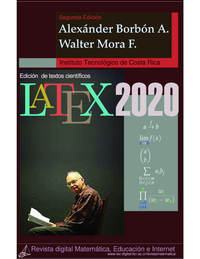
Latex2020
Creación de documentos de alta calidad visual, diseño editorial, ideal para confeccionar una tesis
85 Visitas | 46 Descargas | 2021-04-04 13:44:39 | dhera
Este texto cubre aspectos básicos e intermedios sobre composición tipográfica LaTeX, diseño editorial, presentaciones Beamer, edición adicional de gráficos y figuras con Inkscape y Tikz y entornos con los paquetes xparse y con tcolorbox. También se desarrollan tópicos que tienen que ver con paquetes especiales. Algunas veces la descripción se hace “por ejemplos” y/o usando plantillas de código, dada la vastedad del tema (la documentación de algunos paquetes sobrepasa las mil páginas). Los capítulos que se han incluido son los típicos más frecuentes en la edición de libros y artículos sobre matemáticas, educación, software y programación, según nuestra experiencia. Incluye nuevos paquetes y nuevos comandos que resuelven problemas cotidianos de edición de textos matemáticos de una manera más sencilla. Ahora se consideran nuevas cosas en diseño editorial e infografía y una nueva presentación de los entornos (basada en la versión más reciente de varios paquetes: TikZ, xparse y tcolorbox).
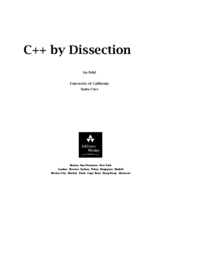
C++ by Dissection
Programación
50 Visitas | 26 Descargas | 2021-04-04 14:19:28 | dhera
C++ by Dissection presents a thorough introduction to the programming process by carefully developing working programs to illuminate key features of the C++ program?ming language. Program code is explained in an easy-to-follow, careful manner through?out. The code has been tested on several platforms and is found on the bundled CD?rom accompanying this text. The code in C++ By Dissection can be used with most C++ systems, including those found in operating systems such as MacOS, MS-DOS, OS/2, UNIX, and Windows.
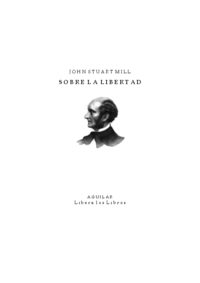
Sobre la Libertad
Libertad de expresión y pensamiento
62 Visitas | 38 Descargas | 2021-04-04 14:27:59 | dhera
Un libro profético. En 1859, Mill dió la voz de alarma sobre los peligros que amenazaban a la libertad individual y que hoy son realidad. Sólo desde nuestros días, pertrechados con la experiencia histórica de este medio siglo, y con lo que nos han revelado sobre su estructura profunda libros como La rebelión de las masas, de Ortega, es plenamente visible el alcance de las agudas intuiciones, de las graves premoniciones de Stuart Mill en este ensayo
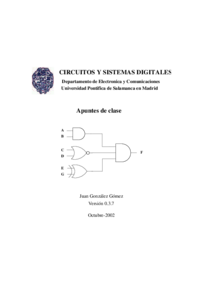
Circuitos y sistemas digitales
Electrónica digital. Ejemplos y ejercicios resueltos
88 Visitas | 51 Descargas | 2021-04-04 17:50:56 | dhera
En la introducción hemos visto la importancia que tienen los números en los sistemas digitales. En el capítulo 2 veremos las diferentes formas de representar un número y en concreto nos centraremos en el sistema binario. Para poder diseñar circuitos digitales, que manipulen números en binario, primero habrá que manejar las matemáticas que hay detrás: el algebra de boole, que se verá en el capítulo 3. Describiremos un tipo de circuitos, los circuitos combinacionales, mediante funciones booleanas y en el capítulo 4 veremos cómo se pueden implementar mediante puertas lógicas. En el capítulo 5 describiremos otros circuitos combinacionales más complejos, constituidos a partir de puertas lógicas, pero que se pueden considerar como componentes electrónicos: multiplexores, demultiplexores, codificadores, decodificadores, comparadores... y en el capítulo 7 cómo es posible realizar operaciones aritméticas. A partir del capítulo 8 se empiezan a ver cirucitos secuenciales, que se caracterizan porque pueden “recordar” o almacenar números. Los biestables nos permiten almacenar 1 bit de información y agrupándolos en registros (capítulo 9) almacenamos más información. Finalmente estudiaremos los contadores (capítulo 10) y los autónomas finitos (capítulo 11)
LabView. Getting Started with LabVIEW
Guía básica de LabView
47 Visitas | 32 Descargas | 2021-04-04 18:01:58 | dhera
Use this manual as a tutorial to familiarize yourself with the LabVIEW graphical programming environment and the basic LabVIEW features you use to build data acquisition and instrument control applications. This manual contains exercises that you can use to learn how to develop basic applications in LabVIEW. These exercises take a short amount of time to complete and help you get started with LabVIEW. The end of each chapter includes a summary of the main concepts taught in that chapter. Use these summaries to review what you learned
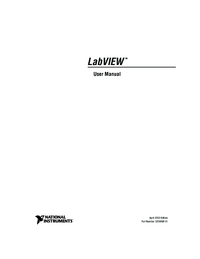
LABVIEW. User Manual
Manual de LabView publicado por National Instruments
62 Visitas | 42 Descargas | 2021-04-04 18:11:53 | dhera
Use this manual to learn about LabVIEW programming features, including the LabVIEW user interface and programming workspaces, and the LabVIEW palettes and tools. This manual does not include specific information about each palette, tool, menu, dialog box, control, or built-in VI or function. Refer to the LabVIEW Help for more information about these items and for detailed, step-by-step instructions for using LabVIEW features and for building specific applications. Refer to the LabVIEW Documentation Resources section of Chapter 1, Introduction to LabVIEW, for more information about the LabVIEW Help and accessing it.
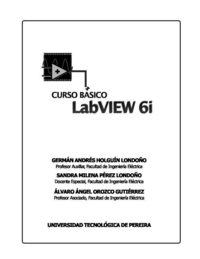
CURSO BÁSICO DE LABVIEW 6i
Tutorial de LabView
48 Visitas | 59 Descargas | 2021-04-04 18:20:27 | dhera
LabVIEW (Laboratory Virtual Instrument Engineering Workbench) es un sistema de desarrollo basado en programación gráfica orientado a desarrollar aplicaciones para instrumentación que integra una serie de librerías para comunicación con instrumentos electrónicos como GPIB, RS232 o RS485 con tarjetas de adquisición de datos, sistemas de adquisición y acondicionamiento como VXI o SCXI, comunicaciones en redes TCP/IP, UDP, o en los estándares de software COM, OLE, DDE, DLL o ActiveX para Windows, así como AppleEvents para MacOS o PIPE para UNIX.
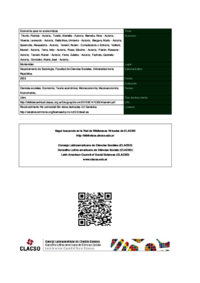
Economía para no economistas
62 Visitas | 40 Descargas | 2021-04-04 18:48:45 | dhera
Esta segunda edición corregida y actualizada, al igual que la anterior pretende contribuir a la enseñanza de Economía de los estudiantes de cursos introductorios, especialmente de las carreras de Ciencia Política, Sociología y Trabajo Social de la Facultad de Ciencias Sociales de la Universidad de la República. Asimismo, creemos que puede ser también adecuado para otros cursos similares de otras facultades o institutos universitarios o no universitarios. Es más, consideramos que este texto es adecuado para aquellos que deseen incorporar conocimientos básicos de Economía de manera extracurricular.
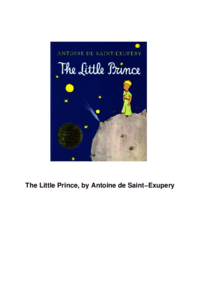
The Little Prince
53 Visitas | 39 Descargas | 2021-04-04 19:06:58 | dhera
I ask the indulgence of the children who may read this book for dedicating it to a grown?up. I have a serious reason: he is the best friend I have in the world. I have another reason: this grown?up understands everything, even books about children. I have a third reason: he lives in France where he is hungry and cold. He needs cheering up. If all these reasons are not enough, I will dedicate the book to the child from whom this grown?up grew. All grown?ups were once children?? although few of them remember it. And so I correct my dedication: To Leon Werth when he was a little boy
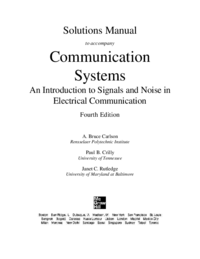
Solutions Manual to accompany Communication Systems An Introduction to Signals and Noise in Electrical Communication
Fundamento de las comunicaciones. Telecomunicaciones y electrónica
60 Visitas | 41 Descargas | 2021-04-21 04:47:21 | dhera
Manual de soluciones a los ejercicios del Libro de fundamento de las comunicaciones Communication Systems An Introduction to Signals and Noise in Electrical Communication. Este libro en formato PDF es útil para estudiantes de las carrera de Telecomunicaciones y electrónica
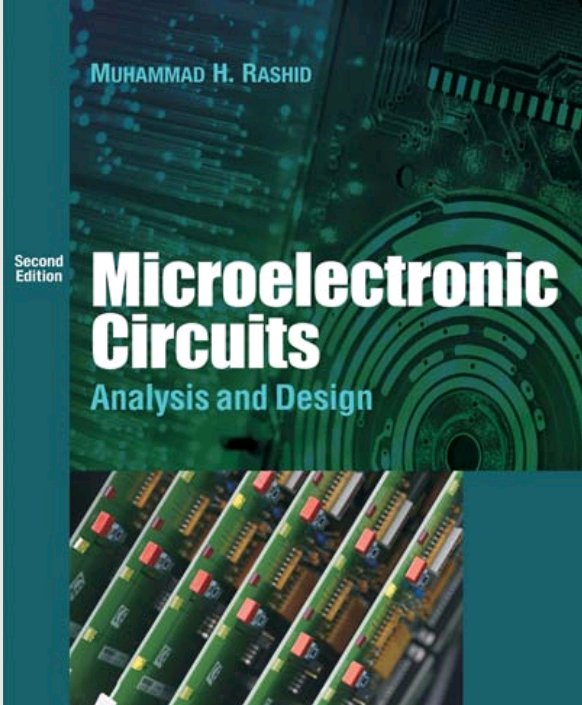
Microelectronic Circuits Analysis and Design
Electrónica Analógica
64 Visitas | 61 Descargas | 2021-05-05 20:47:00 | dhera
Semiconductor devices and integrated circuits (ICs) are the backbone of modern technology, and thus the study of electronics—which deals with their characteristics and applications—is an integral part of the un?dergraduate curriculum for students majoring in electrical, electronics, or computer engineering. Tradi?tionally, the basic course in electronics has been a one-year (two-semester) course at most universities and colleges. However, with the emergence of new technologies and university-wide general education re?quirements, electrical engineering departments are under pressure to reduce basic electronics to a one?semester course. This book can be used for a one-semester course as well as a two-semester course. The only prerequisite is a course in basic circuit analysis. A one-semester course would cover Chapters 1 through 8, in which the basic techniques for analyzing electronic circuits are introduced using ICs as examples. In a two-semester course, the second semester would focus on detailed analysis of devices and circuits within the ICs and their applications.
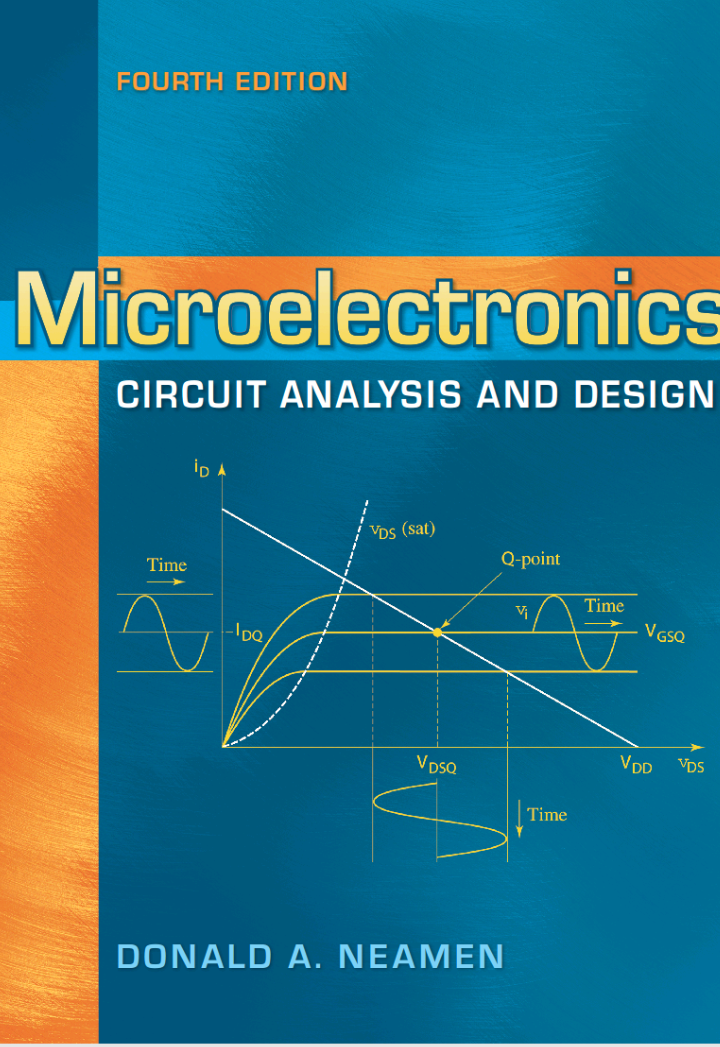
Microelectronics
Electrónica Analógica
84 Visitas | 50 Descargas | 2021-05-16 06:09:44 | dhera
Microelectronics: Circuit Analysis and Design is intended as a core text in electron?ics for undergraduate electrical and computer engineering students. The purpose of the fourth edition of the book is to continue to provide a foundation for analyzing and designing both analog and digital electronic circuits. A goal is to make this book very readable and student-friendly. Most electronic circuit design today involves integrated circuits (ICs), in which the entire circuit is fabricated on a single piece of semiconductor material. The IC can contain millions of semiconductor devices and other elements and can perform complex functions. The microprocessor is a classic example of such a circuit. The ultimate goal of this text is to clearly present the operation, characteristics, and limitations of the basic circuits that form these complex integrated circuits. Although most engineers will use existing ICs in specialized design applications, they must be aware of the fundamental circuit's characteristics in order to understand the operation and limitations of the IC. Initially, discrete transistor circuits are analyzed and designed. The complexity of circuits being studied increases throughout the text so that, eventually, the reader should be able to analyze and design the basic elements of integrated circuits, such as linear amplifiers and digital logic gates. This text is an introduction to the complex subject of electronic circuits. Therefore, more advanced material is not included. Specific technologies, such as gallium arsenide, which is used in special applications, are also not included, although reference may be made to a few specialized applications. Finally, the layout and fabrication of ICs are not covered, since these topics alone can warrant entire texts.
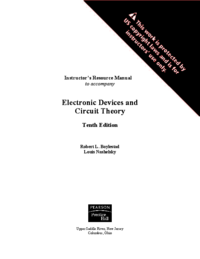
Solucionario Boylestad 10ma edición
78 Visitas | 55 Descargas | 2021-05-16 06:17:44 | dhera
Solucionario del libro de electrónica analógica Robert L.Boylestad 10ma edición. Y los laboratorios resueltos
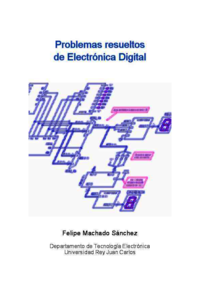
Problemas resueltos de electrónica digital
Electrónica Digital
86 Visitas | 67 Descargas | 2021-05-16 06:44:05 | dhera
En este manual se han recopilado algunos de los problemas propuestos en clase y en exámenes de la asignatura Electrónica Digital I de la titulación de Ingeniería de Telecomunicación de la Universidad Rey Juan Carlos (URJC). Los problemas tratan los sistemas de numeración y su aritmética, el álgebra de Boole, el diseño de circuitos con puertas lógicas y bloques combinacionales, el diseño de contadores y el análisis de circuitos sencillos. Como los problemas de los sistemas de numeración y álgebra de Boole son más cortos, muchos de estos ejercicios se han agrupado en un mismo capítulo, mientras que los ejercicios más largos, que suelen combinar más de un tema, se han puesto de manera individual en un sólo capítulo.
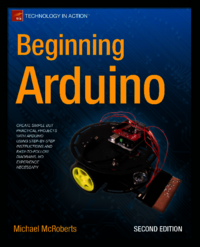
Beginning Arduino
70 Visitas | 53 Descargas | 2022-06-21 16:29:27 | dhera
Since the Arduino Project started in 2005, over 500,000 boards have been sold worldwide to date. The number of unofficial clone boards sold no doubt outweighs the number of official boards, and it’s likely that over a million Arduino boards or its variants are out in the wild. Its popularity is ever increasing as more and more people realize the amazing potential of this incredible open source project and its ability to create cool projects quickly and easily with a relatively shallow learning curve. The biggest advantage of the Arduino over other microcontroller development platforms is the ease of use in which non-“techie” people can pick up the basics and create their own projects in a relatively short amount of time. Artists in particular seem to find it the ideal way to create interactive works of art quickly and without specialist knowledge of electronics. There is a huge community of people using Arduinos and sharing their code and circuit diagrams for others to copy and modify. Most of this community is also very willing to help others and to provide guidance and the Arduino Forum is the place to go if you want answers quickly. However, despite the huge amount of information available on the Internet for beginners, most of this information is spread across various sources, making it tricky for beginners to obtain the information they want. This is where this book fits in. Within the pages you are about to read are 50 projects that are all designed to take you step by step through the world of electronics and programming your Arduino in an easy to follow manner. I believe that the best way to learn anything is to jump in and just do it. That is why this book will not bore you with pages and pages of theory before you start to use your Arduino. I know what it is like when you first get an Arduino, or any new gadget: you want to plug it in, connect an LED, and get it flashing right away, not read through pages of manuals first. This author understands that excitement to get going and that is why we will dive right into connecting things to our Arduino, uploading code, and getting started right away. This is, I believe, the best way to learn a subject and especially a subject like physical computing, which is what the Arduino is all about.
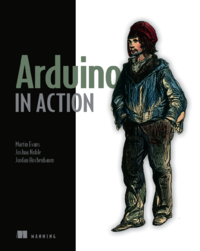
Arduino in Action
64 Visitas | 43 Descargas | 2022-06-21 16:33:48 | dhera
This book is organized into two parts. Part 1 discusses the Arduino in general and includes a tutorial that introduces you to your first project before looking at a couple of simple projects that use the Arduino inputs and outputs. Part 2 looks at the Arduino in more depth, and this is where we really start to put the Arduino to work with a number of advanced techniques that you can use in your own projects. Code for the sketches covered in each chapter is available online via the book’s website: www.manning.com/ArduinoinAction. We suggest trying to follow along with the projects in the book as much as you can. Typing in the individual code listings will help to fix concepts and ideas into your mind. This book is suitable for both beginners and intermediate Arduino users. It starts from a very basic level and assumes no prior knowledge, but we think even expert users will gain things from the second part of the book, which covers a wide variety of subjects, many of which can be combined into your own projects. A basic understanding of electronics will help with some project circuits, although we endeavor to explain them as much as we can.
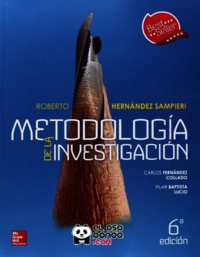
Metodología de la investigación
114 Visitas | 73 Descargas | 2022-06-21 16:40:48 | dhera
Metodología de la investigación, 6ª edición, es una obra completamente actualizada e innovadora, acorde con los últimos avances en el campo de la investigación de las diferentes ciencias y disciplinas. Asimismo, como sus ediciones antecesoras, es resultado de la opinión y experiencias que han proporcionado decenas de docentes e investigadores en Iberoamérica, Estados Unidos y Canadá. Conserva su carácter didáctico y multidisciplinario, pero expande sus perspectivas, ya que es un libro interactivo que vincula el contenido del texto impreso con el material incluido en su centro de recursos en línea, y que a lo largo del libro se ha destacado con el icono que se muestra al costado.
Contribuir
Usted puede contribuir con Libros UCLV, es importante para nosotros su aporte..
Contribuir